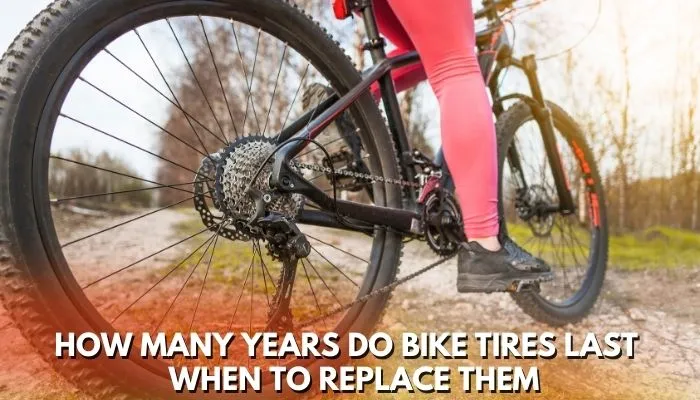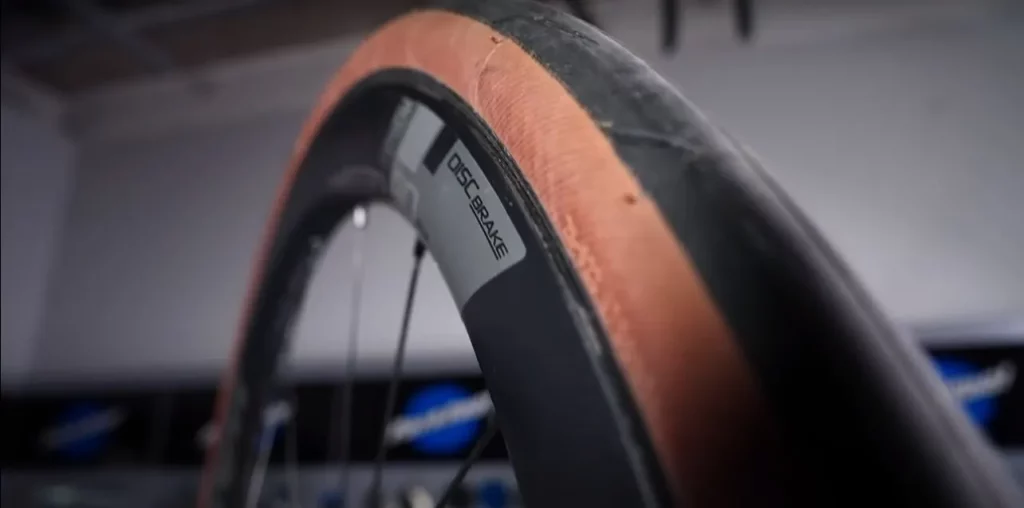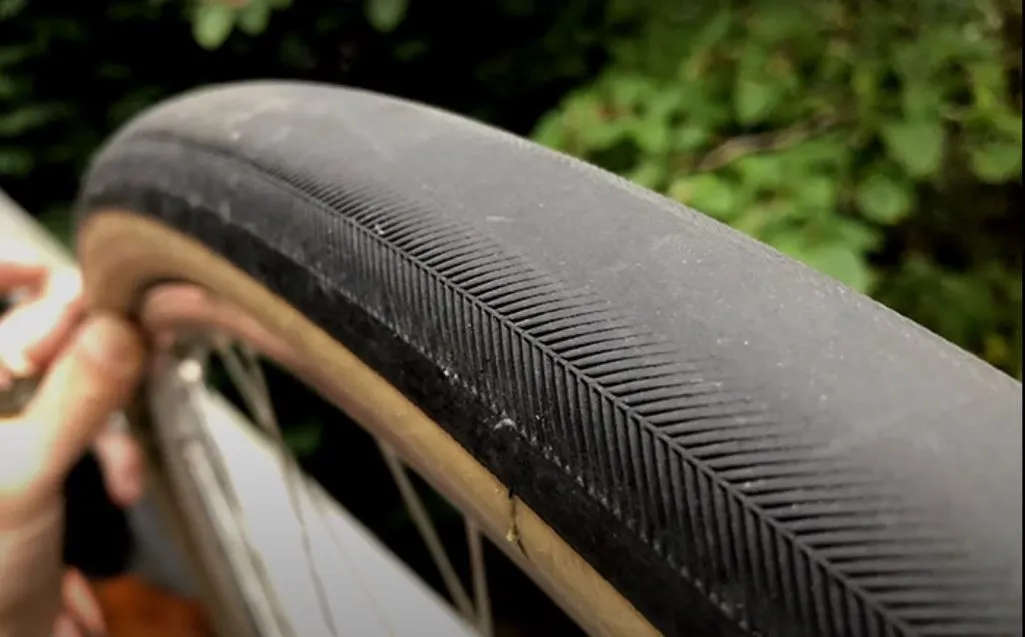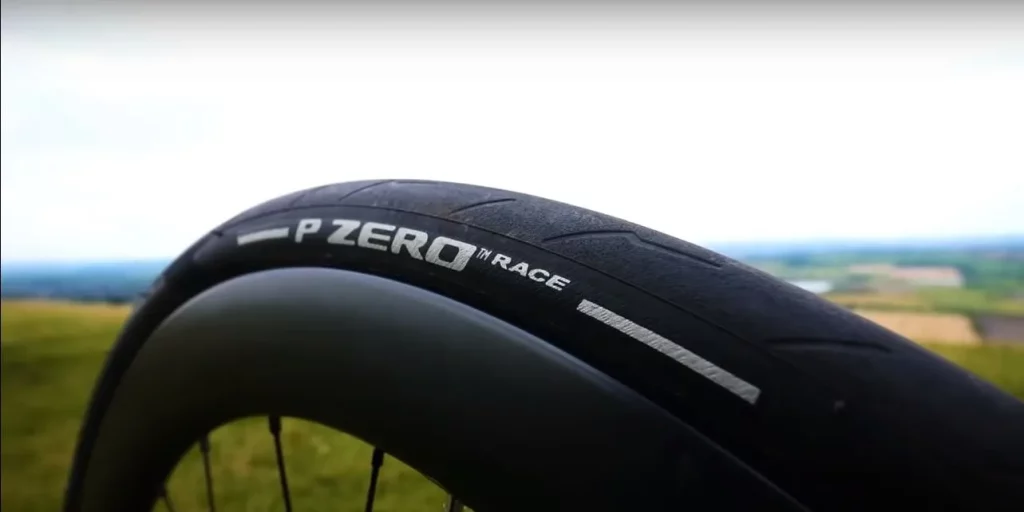How Many Years Do Bike Tires Last | When To Replace Them

One of the most immediate concerns when riding a bike is how long your tires will remain. This question only gets more important when you’re commuting, considering your tires may end up becoming the most crucial component of your complete rider setup.
How Many Years Do Bike Tires Last?
Between 2000 and 3500 kilometers is the normal tire lifespan for bikes. Racing tires that are lightweight have an 800 to 1000-mile lifespan. Touring tires can last between 3500 and 4500 kilometers and are sturdy. How long a tire will survive is determined by a variety of factors, such as the tire’s composition, the type of route it is on, and how well you keep on top of it.
Treating your tires the same way you would your shoes is an awesome suggestion in many ways. You wouldn’t leave the house wearing out-of-date footwear that could cause you to slip and fall or be hazardous. Why would you drive about on faulty tires that can blow out and leave you abandoned? Let’s learn more about tires, including their estimated lifespan and other facts.
Table of Contents
How Many Years Do Bike Tires Last

The better method for determining a tire’s lifespan is in miles because the more you use them, the more probable it is that they will wear out. Trail tires are a common characteristic of mountain bikes. These tires typically have a lifetime of between 3,000 and 8,000 miles.
The lifespan of other tire types is shorter than that of Mountain bike trail tires. Between 1,000 and 3,000 miles are provided by road bike tires. The premium tires used for daily commuting have an expected lifespan of slightly more than 2,500 miles. Touring tires, on the other hand, have a 4,000-mile lifespan. The race tires, however, only have a limited lifespan of 1,000 miles.
How Can You Tell if Your Tires Need To Be Replaced?

The foundation for a bike’s mobility is its tires, regardless of the fact that they are at its bottom. Unless you intend to fly, your bike cannot travel without tires. As a result, the tires on a bike are essential, and as we already know, no manufacturer can predict with precision when your tires will begin to deteriorate in their effectiveness.
They can only provide you with a projected mileage (as we have earlier done). Sadly, we are not able to provide you with a certain timeframe as well. But, you may determine how long your tires will survive by using a few of the provided recommendations, such as checking the threads in your tires, searching for damage, and checking the sidewalls and crisscross threading.
- Look at the threads
Your best bet for spotting an old tire is glancing at its thread. This method is also the simplest and quickest approach to determining whether a tire is deteriorating. So, what exactly is a thread, and how do you inspect it to determine whether your tires must be changed?
Tires have thick or thin lines engraved into them termed “thread,” which mimics a birthmark. When the tire grinds against the ground when riding, the threads which are attached to the tires help to cause tension. The threads on many bikes are different from one another. Some of the lines are thick and deep, whereas others are thin and not as deep. In general, the less visible the threads, the speedier the bike is intended to go.
Hence, to examine the threads of your bike, start looking for any residual thread that remains in your tires. Your bike tires have grown older, as you can tell by the fewer threads you see. Make sure to examine your bike’s thread as soon as you purchase it since doing so can seem hard, especially if you are inexperienced with the design of the thread on the bike. The bike thread can also be found online by conducting a web search.
But be aware that some bike models, such as touring bikes, lack threads. They feature contact patches in place of that. However, there is another method for detecting because patches are more difficult to identify.
- Verify any damage.
Examining the tire for damage is another way to notice anything. Depending on the type of road you drive your bike, damage to your bike’s tires may happen. Tire damage occurs more quickly on rough roads when compared to smooth ones. You can tell which types of damage you might experience by the type of roadway you are biking on.
There are numerous types of damage, such as rips, scratches, tears, flat patches, and punctures. The most prevalent issue is punctured, which can occur rather frequently over the course of a bike tire’s lifespan. It takes place when your tire starts to lose pressure as a response to a tire hole. Your tire will quickly become flat as a result of this. It might occur as a consequence of a riding object such as a pin, nail, or thorn rupturing the tires. Checking for these signs before riding is a great piece of advice for tire upkeep. And if a tire becomes punctured, you can fix it right away.
- Crisscross threads
Checking for crossed threads is another method of determining a tire’s condition or whether to change the tires on your road bike. Regular threads are distinct from crisscross threads. Threads disappear while crossed threads form on tires as they wear, indicating wear and tear. What exactly are crisscross threads, then?
It is the safety belt that is positioned beneath each bike tire’s rubber. And because of the crisscross pattern of its weaving, it is regarded as a crisscross thread. They are not visible through the tire‘s outermost surface because it is comprised of carcass thread.
You will need to replace your bike tire, though, when they do start to appear in any part of it. Nonetheless, we suggest that you change your tires before you detect the belt. You should get ready to get a new one if the breakage is a little too severe or if all of the thread marks are missing.
- Sidewalls
When evaluating the endurance of your tires, you should also look at the sidewall. That area is the tire’s flank. And in addition to the thread on the tires, there is yet another excellent method for determining the quality of your tire. If you pay close attention to a new bike’s sidewall is typically full and thick.
What may have caused the fracture varies depending on the type of crack. Your bike’s sidewall has long cracks, suggesting that the tire pressure was insufficient when you were riding it. If the crack is evenly spaced, this is just an indication that your tires are becoming old and will soon have to be replaced.
Taking care of the sidewalls of your bike is easy. To achieve this, make sure you take your car to a reliable repair shop for tuning. There, you can also go to get other components of your bike fixed or repaired. The bike’s other components and any damages will be evident when you take it in for inspection, which will give you time to repair it. Some things, like handlebars, are fixable by the rider.
How Can You Extend The Life of Your Bike Tires?

You can use the following advice to extend the life of your bike tires:
- Select the Correct Tire
The ideal type of tire exists for every kind of road. If you use thin road tires on trails or mountain bike tires on pavement, you can’t really expect them to function any longer.
- Put on safety gear
There are specialized tire guards accessible that may protect your bike tires from Ultraviolet radiation, ozone, toxins, and the environment.
- Adjust the inflation
Assess how the Weight is dispersed and change the tire inflation as needed. Life expectancy will increase significantly despite the fact that it may not seem like much.
- Minimize Weight
Make an effort never to go over the tires’ recommended maximum weight capacity. The tires may be maintained in good condition in such a simple manner.
How Much Do a Set of Bike Tires Cost on Average?

In a nutshell, it is dependent. Each type of tire has varied pricing, and each bike has a different set of needs for tires. It’s impossible to establish a precise average price for bike tires because there are so many different types.
Several tread designs, size ranges, widths, and other choices are available for tires. Yet, some tires have unique characteristics such as enhanced traction, adhesive sides, flat prevention, casings, rupture resistance, etc., and these tires are substantially more costly than standard bike tires.
How Can You Extend The Life of Your Bike Tire?
- Every few days, check that the inflating is accurate, particularly if there have been huge temperature fluctuations.
- Rotate your tires every four to six months from front to back and from back to front. Since the rear tire often wears down more rapidly than the front, taking this step will ensure that you are receiving the most useful available out of them.
- Do your best to avoid slamming into potholes and obstacles.
- Don’t drive on a flat tire.
How Long Do Bike Tires Last in Storage?
According to Expert, properly maintained bike tires should last for approximately three to six years. The precise lifespan will, however, differ depending on the type of tire, its manufacturer, its condition, how much temperature, moisture, etc., it has been subjected to, and other considerations.
Bicycle tires could degrade in a short amount of time in unfavorable conditions. One other thing to keep in mind is that high-performance tires typically have a softer, more grippy rubber compound. Despite the fact that this greatly enhances traction on the surface or on the road, it does indicate that they will unavoidably deteriorate more rapidly over time—both when being used and when they are stored.
FAQs:
How frequently should bike tires be changed?
A bike tire has an average life expectancy of 3,000 to 4,000 miles, regardless of whether it is used for road racing or mountain biking.
But, there are other indicators of wear and tear, such as lack of tread, degradation, rubber fractures, sidewall cuts, and poor performance, that are far more significant than the mileage you bike.
How can I tell if my bike tires need to be replaced?
Searching for the TWI is the simplest way to accomplish this (tread wear indicator). This visual indicator, which may be seen inside the tread grooves, verifies the amount of tire wear
You should think about purchasing a new tire if the tread wears down to that point visibly on the tire.
Can I use tires that are seven years old?
Regardless of the level of the tread, worn tires are hazardous. While there is no formally recognized regulatory safety guideline on how old a tire should be before it becomes unsafe, many manufacturers advise changing it six years after it was first manufactured. In tragic accidents, worn-out tires have been to blame.
Conclusion:
If you can feel the wind in your hair while biking, it is more than just pleasurable. Yet, it goes beyond just being fast and enjoyable. Moreover, upkeep and preservation are involved. Before embarking on every ride, you must constantly check the condition of your tires (the basis
If you ride a road bike, your tires have a normal lifespan of 1000 to 3000 miles. Also, this is based on how frequently you use, where, and how you ride your bike. It also depends on how often you have your bike examined. Therefore, if someone asks, ” How many years do bike tires last
It is not an easy question to answer, as you now know. Numerous factors impact a road bike tire’s lifespan. Yet with good care, maintenance, and examination on a routine basis, you can always prolong the lifespan of your bike tires.
